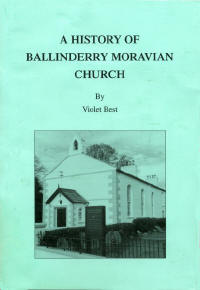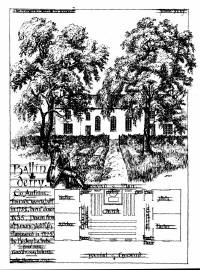 |
 |
|
Front Cover of Book and an Artist's
impression of the Moravian Church c 1825. It was
built in 1751 by John Cennick. altered and added
to in 1821 and rebuilt in 1835 after it was
destroyed by fire. The plan shows that the
entrances to the earlier church and house were
from the burial ground side. |
|
� Violet Best 2000
Published by Ballinderry Moravian Church
Lower Ballinderry Co Antrim
to mark 250 years of Moravian work. |
This book can be obtained at
Ballinderry Antiques
Ballinderry
and
Faith Mission Bookshop
Railway Street
Lisburn
FOREWORD
The Ballinderry Moravian Church has a special place in our affections,
having ministered there for 19 years, so we welcome Violet Best's history
of the congregation.
Here is a record of joys and setbacks during 250 years, from the arrival
of the evangelist John Cennick in 1750 until the present day. Violet
records the building of the first church, its accidental destruction by
fire on Easter Sunday 1835 and its rebuilding and dedication by May of the
following year. She tells of the poverty of some of the population during
the famine years and the support offered to fishermen around Lough Neagh.
We are happy to commend this book. We hope it will interest all readers
and be an inspiration to the present members of the congregation.
Joe and Edna Cooper.
�Top
ACKNOWLEDGEMENT
My thanks to Joe and Edna Cooper for their advice, to Thomas Chapman for
technical assistance with computing and to James Best for his photography.
Sources: There are no Ballinderry congregation diaries
extant prior to 1842 so the following sources have been used: Extracts
from the transcript of the Journals of John Cennick (edited J.H.Cooper
1996): A German manuscript of 1750 in Dublin archive: Diary extracts re
Ballinderry 1750 - 1755, published in Fraternal Records Vol 1. (edited
John Carey 1858). Gloonen, Gracehill and Dublin congregation diaries and
Elders Conference Minutes in Gracehill archive (courtesy V. Launder).
After 1842: Ballinderry congregation diaries and congregation reports from
Moravian Messengers in Church House London.
N.B. Britain changed to the Gregorian calendar on
September 3rd 1752, making a difference of 11 days. In Germany `new style'
was already in use and early Moravian diaries used `old' or `new style',
and sometimes both. The editor of the Fraternal Record altered the dates
to `new style' but the Cennick Journal was written and edited in ,old
style'.
| December 2000. |
Violet Best. |
�Top
BALLINDERRY MORAVIAN CHURCH
The Moravian Church and old manse occupy a site in the
centre of the village of Lower Ballinderry. The building has roughcast
cream walls with three roundheaded Georgian-glazed windows on each side;
the gable of the church has a small bell-cote and porch. To find out what
a church with a foreign sounding name is doing in this village in County
Antrim we need to take a brief look at the history of the Moravian Church.
�Top
WHO ARE THE MORAVIANS?
Within the British Isles there are only 35 congregations
and 6 societies. In Northern Ireland there are 5 congregations, so it is
not surprising that many people have never heard of the Moravians, or been
inside one of our churches.
The Moravian Church is an ancient Protestant Episcopal
Church founded in 1457 in Bohemia (now part of the Czech Republic) by the
followers of John Hus, the religious reformer and martyr. Hus became a
celebrated preacher in the Bethlehem Chapel in Prague and attracted large
crowds as he read the Bible and preached in the Czech language (all
services in those days were conducted by priests in Latin, which few could
understand). Although the Church excommunicated John Hus, the people loved
him. When he refused to yield to those in power and stood firm on the
teachings of the Bible, he was burned at the stake on the 6th July 1415,
his 46th birthday, and his ashes scattered on the river Rhine.
Following the death of Hus fierce conflict ensued in
Moravia, but in 1457 some of the more earnest followers of his teaching,
realising that reform had failed, withdrew to a village called Kunwald.
There, 60 years before Martin Luther's Reformation in Germany, they
established a community living in brotherly fellowship, and in 1467 made a
decision to separate from Rome and to establish their own ministry. This
new Church, known as the Unitas Fratrum (a unity of brethren), grew
rapidly and established congregations in many parts of Bohemia and
Moravia. It produced the first Protestant hymnbook in Prague in 1501, and
then in 1579 printed the Kralitz Bible which is a translation from the
original Hebrew and Greek into the Czech language. There was also great
emphasis put on Christian education and many schools and colleges were
founded.
However, troubled times lay ahead, persecution following
the Counter Reformation resulted in the Unitas Fratrum being almost wiped
out in the land of its birth. In 1628 a Moravian Bishop, John Amos Comenius, who in the midst of this terrible persecution, when its leaders
were being executed, its churches burnt, and its members imprisoned and
tortured, led a party of Moravian refugees across the deep snow of the
Giant Mountains to safety in Poland. It was his hope that eventually these
refugees might act as a `hidden seed' from which the ancient Unitas
Fratrum might revive again. Comenius was a man of international renown,
particularly in the field of education, and was the first to use pictures
as a teaching aid. In time he became known as the `father of modern
education'.
The hope and faith of Comenius that a hidden seed would
survive were vindicated when in 1722 some Brethren descendants left their
native Moravia, made their way to Saxony and found refuge on the estates
of a young Lutheran nobleman, Count Nicholas von Zinzendorf After a time
Zinzendorf became their leader and under his influence the Church found
renewal. Others seeking refuge augmented this small group until the
population numbered about 300, and because many came from Moravia in time
they were called Moravians. The settlement was named HERRNHUT, which meant
`a place the Lord watches over'. Members were divided into `choirs'
according to their age, sex and marital status. Each group lived in their
own choir house and this formed the pattern for settlements such as those
in Fulneck, Fairfield and Ockbrook in England and Gracehill in Northern
Ireland.
�Top
HOW THE MORAVIANS CAME TO THE BRITISH ISLES
The renewed Church in Herrnhut felt the call of God to
take the Gospel into the world and was soon sending out missionaries to
the remote places of the earth. In the early days, Moravian Church policy
was to evangelise in places where the Christian message had not been
preached, or to which they had been invited. Some missionaries, on their
way to Georgia in America, broke their journey in London and this began
their expansion into the British Isles. At the time it was not the
intention to set up a separate Church but to organise people in societies
to deepen their spiritual life and encourage their return to their
churches.
�Top
|